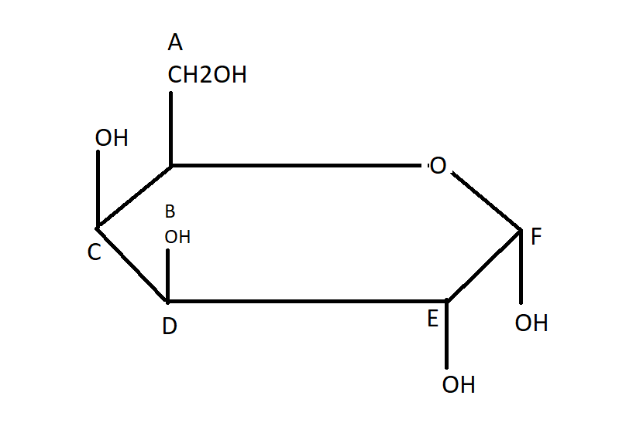
One cyclic acetal form of D-galactose is shown.
Which name most completely describes this cyclic acetal form?

$A.\alpha - D - Galactofuranose$
$B.\beta - P - Galactofuranose$
$C.\alpha - D - Galactopyranose$
$D.\beta - P - Galactopyranose$

Answer
462.3k+ views
Hint: Here, the carbon atom refers to the very first carbon atom, which attaches to a functional group. Also, the hydroxyl group on carbon-5 is on the right side of the Fischer projection. It is a six-membered ring.
Complete answer:
Full name consists of anomeric carbon, i.e., whether it’s $\alpha $, or $\beta $. So, alpha $\left( \alpha \right)$ carbon in an organic compound refers to the very first carbon atom, which attaches to a functional group.
Then, the configuration of the last chiral center, i.e., whether it is D or L. So, in the case of a galactose when the hydroxyl group on carbon-5 is on the right side of the Fischer projection, the galactose is of D- configuration.
Then we should lastly put the name of carbohydrate with the name of the cyclic form.
As it is a six-membered ring in the given figure, the name is $\alpha - D - Galactopyranose$.
Now, what the anomeric carbon is. Simply, it is the carbon, which is derived from the carbonyl carbon compound (the ketone or aldehyde functional group). This carbonyl carbon compound must be in its open-chain form of the carbohydrate molecule and the anomerization is the process of conversion of one anomer (cyclic monosaccharides or glycosides that are epimers) to the other.
Now, a chiral center is an atom, which has four different groups attached to it in such a pattern that it must have a non-superimposable mirror image. So, if we draw the mirror image of any molecule and see that they are different, then the molecule is chiral and if they are the same, then it is not chiral.
Hence the correct answer is option C.
Note:
It is to be noted that the cyclic acetals are five or higher-membered monomers with at least one unit in which two oxygen atoms take part on the sides by substituted or unsubstituted methylene group. This is formed by the reaction of two molecules, a ketone and a diol.
Complete answer:
Full name consists of anomeric carbon, i.e., whether it’s $\alpha $, or $\beta $. So, alpha $\left( \alpha \right)$ carbon in an organic compound refers to the very first carbon atom, which attaches to a functional group.
Then, the configuration of the last chiral center, i.e., whether it is D or L. So, in the case of a galactose when the hydroxyl group on carbon-5 is on the right side of the Fischer projection, the galactose is of D- configuration.
Then we should lastly put the name of carbohydrate with the name of the cyclic form.
As it is a six-membered ring in the given figure, the name is $\alpha - D - Galactopyranose$.
Now, what the anomeric carbon is. Simply, it is the carbon, which is derived from the carbonyl carbon compound (the ketone or aldehyde functional group). This carbonyl carbon compound must be in its open-chain form of the carbohydrate molecule and the anomerization is the process of conversion of one anomer (cyclic monosaccharides or glycosides that are epimers) to the other.
Now, a chiral center is an atom, which has four different groups attached to it in such a pattern that it must have a non-superimposable mirror image. So, if we draw the mirror image of any molecule and see that they are different, then the molecule is chiral and if they are the same, then it is not chiral.
Hence the correct answer is option C.
Note:
It is to be noted that the cyclic acetals are five or higher-membered monomers with at least one unit in which two oxygen atoms take part on the sides by substituted or unsubstituted methylene group. This is formed by the reaction of two molecules, a ketone and a diol.
Recently Updated Pages
Using the following information to help you answer class 12 chemistry CBSE

Basicity of sulphurous acid and sulphuric acid are

Master Class 12 Economics: Engaging Questions & Answers for Success

Master Class 12 Maths: Engaging Questions & Answers for Success

Master Class 12 Biology: Engaging Questions & Answers for Success

Master Class 12 Physics: Engaging Questions & Answers for Success

Trending doubts
What is the Full Form of PVC, PET, HDPE, LDPE, PP and PS ?

Figure shows a conducting loop ABCDA placed in a uniform class 12 physics CBSE

Explain with a neat labelled diagram the TS of mammalian class 12 biology CBSE

The first general election of Lok Sabha was held in class 12 social science CBSE

How do you convert from joules to electron volts class 12 physics CBSE

The term ecosystem was coined by a EP Odum b AG Tansley class 12 biology CBSE




